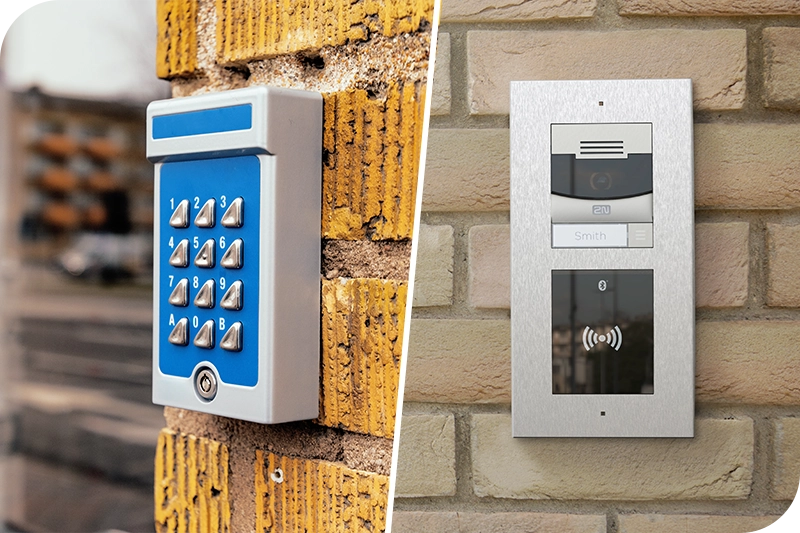The history of door access control systems
 Camilla Ashdown, 04. 05. 2023 | 5 min read
Camilla Ashdown, 04. 05. 2023 | 5 min read
Whilst the future of access control is a hot topic in the industry currently, the history is also of great interest! Grab a coffee and let’s dive in to how we’ve evolved over millennia to arrive at the IP door access control systems we know today…

What is access control?
Put simply, controlling access to something. It doesn’t have to be only buildings – access control exists across many areas (for example data control, border control, etc.)
Door access control systems, however, has been an important consideration throughout history, from the earliest human settlements to Ancient Egyptian tombs, and eventually to modern high-rise apartments that use the latest technology. The need to protect people and the property they deem valuable has led to the development of various amazing technologies over the years: but it started off in a somewhat abstract way!
In fact, the earliest (and somewhat simple) form of access control is often regarded as human intervention: for example, the use of people acting as guards to protect buildings or other areas from unauthorized access. However, as settlements grew, the need for more sophisticated access control systems became apparent.
Early technology: the need for locks emerges
The first known lock and key is believed to have been invented over 6000 years ago – and one early example was discovered in the ruins of Nineveh, the capital of ancient Assyria, around 600BC.
This was a simple device often termed a ‘pin tumbler lock’. It consisted of a wooden post affixed to the door and a bolt that would slide into it. The person opening it would use a large, wooden key with prongs (that matched the openings inside) to lift a series of movable pin tumblers into a position that allowed the wooden bolt to slide open. When the key was removed, the pins fell back into the bolt, preventing it from opening.
Sounds familiar, right? The mechanism is actually very close to what some locks and keys are like today – in the euro cylinder mechanism, for example.
This technology was advanced by the Greeks and Romans. In fact, some of the locks used in ancient Rome were so complex that they could only be opened by specially trained locksmiths! Interestingly, having anything so precious that it would need locking up with what would’ve been (for the period) extremely advanced or expensive technology was relatively rare, so locks and keys were less of a necessity as they are today - and more of a status symbol.
Unlike the ancient Egyptians, Greeks and Romans crafted their mechanisms from metal and other more durable materials. In ancient Greece, locks and keys were made of bronze or iron and were often decorated with intricate patterns. The locks were typically cylindrical in shape and – like the pin tumbler lock - had a series of pins that had to be aligned by the proper key to unlock the device. The keys themselves were often long and thin, with teeth that corresponded to the pins in the lock.
In ancient Rome, locks and keys were also made of bronze or iron and bore similarities to Greek designs. However, the Romans also developed a type of lock called a "warded lock," which was made up of a series of obstructions (wards) that prevented the key from turning unless it was the correct shape. Warded locks were popular for many centuries and are still used in some modern padlocks.
The Middle Ages and beyond
During the Middle Ages, locks and keys became more widespread. These locks were often made by blacksmiths and were relatively simple in design, consisting of a bolt and a key.
Interestingly, back then, locks and keys weren’t used to secure buildings (which were typically secured by heavy wooden doors that were barred from the inside), but instead were used primarily to secure valuable items, such as treasure chests, strongboxes and other portable items that could be easily stolen. These locks were typically made of iron and were large and heavy, with complex mechanisms designed to prevent unauthorized access.
One popular type of lock during this period was the warded lock. This type of lock had a series of wards or obstacles inside the lock that prevented the key from turning unless it was the correct key with the corresponding grooves to bypass the wards: very similar to the tumbler technology that came before. Warded locks were relatively easy to pick, so they were often combined with other security measures, such as chains and guards.
Locksmiths during the Middle Ages were highly skilled craftsmen who created locks and keys by hand, and they often worked for wealthy families or institutions such as monasteries or castles. They kept detailed records of their work and techniques, which were often passed down through generations – and were built upon greatly in the ensuing years!
The Industrial Revolution
The Industrial Revolution brought about significant advancements in the manufacturing and design of locks and keys. The mass production of interchangeable parts paired with the increasingly affordability of metals and other resources allowed for the creation of more intricate and durable locking mechanisms that improved the early technology. Additionally, the increased demand for locks and keys in factories, offices, and homes prompted inventors to develop new types of locks and keys to meet the needs of a growing population.
Two notable advancements during this period were the introduction of two new locks still in production today. First, in 1818, came the Chubb lock: invented by Jeremiah Chubb and designed to detect or prevent lock picking. It was a four-lever lock that when picked or opened with the wrong key, would stop working until a special key was used to override it.
Then, a significant advancement of the key was made by American inventor Linus Yale Jr. in the mid-19th century – around 1865. The Yale lock – yes, that Yale – used a series of pins and springs that could only be moved by a specific key with grooves that matched the pins – like what was used millennia ago, however the mechanism was placed inside the door instead of on the other side: meaning the key could be much smaller in size.
The majority of keys and locks we use today are based on, and relatively unchanged from, technology from the 19th century. However: the era of the metal lock and key may just be coming to an end.
Electricity and the Internet of Things
In the late 20th century, the development of electronic access control systems revolutionized the industry. The first electronic IP door access control systems were developed in the 1960s and used punch cards to grant access to buildings. These systems were soon replaced by magnetic stripe cards, which were more durable and easier to use.
Of course, these electronic IP door access control systems used something more than a lock to secure the door: which leads us to the invention of the intercom and access control readers. This can be traced back to the mid-20th century. Door intercoms were first introduced in the 1950s and became more widely used in the 1960s. They were often simple audio-only systems that allowed residents or employees to communicate with visitors outside the door before allowing them access.
As technology continued to improve, video intercom systems were developed, providing the ability to see the person outside the door before allowing them entry, and heightening security quite considerably. In the 1980s and 1990s, new digital intercom systems were introduced, offering clearer audio and video quality and greater control over access.
Access readers, which are used to grant or deny access to a building or specific area, were also developed around the same time as door intercoms. The first access readers used magnetic stripe cards, which were swiped to grant access.
In the 1990s, the development of RFID technology allowed for the creation of contactless IP door access control systems. RFID access cards and chips could be used to grant access to buildings without the need for physical contact with the lock. These systems were more secure than magnetic stripe readers and allowed for greater flexibility in managing access, such as restricting access to certain areas at certain times.
Eventually, in the 21st century (2008 to be exact), the first IP intercom was invented by 2N: leading to a whole level of door access control systems with advanced features that had never been seen before.
The Impact of 9/11 and rise of global security
The horrific events of 9/11 had a profound impact on the world as we know it – and access control is not exempt from this. Often considered as the most egregious act of international terrorism, it killed almost three thousand people, injured an estimated twenty-five thousand, and inspired similar attacks across the globe.
Before 9/11, security was somewhat less strict. That’s not to say that border or access control was relaxed per se, but rather that post 9/11, the world became more aware of the potential power of terrorists and, in a collective effort of counterterrorism, subsequently invested a lot of energy in developing advanced technology.
As a result, IP door access control systems began to place a greater emphasis on more secure access verification methods and cyber-security. The idea is to heighten the control of access by making the door access control system as hard to hack as possible, thus preventing potential attacks (especially in sensitive areas such as governmental buildings and hospitals) and leading to a boom of ground-breaking access technology such as the IP intercoms mentioned previously.
Modern day: the rising demand for advanced features and cohesive building solutions
Although the principle of IP door access control systems has remained the same, (i.e. restricting access) technology has evolved to a completely new level. Today, IP door access control systems are used in a wide range of applications, from securing homes and businesses to protecting valuable information in digital systems. Access control is evolving at an unprecedented rate, continue to evolve, with the introduction of new technologies such as smart locks and integrated security systems.
Door access control systems have evolved even further since the development of mobile access control systems.These systems allow users to access buildings using their smartphones or other mobile devices – often, via Bluetooth technology that is embedded in smart IP intercoms and access readers. Mobile access offers more convenience without compromising on safety, reliability or even the speed in which the door can be open and has led to a total overhaul of what the lock and key is: indeed, removing the latter entirely!
It could be argued that IP intercoms and access readers are even replacing traditional locks, and that soon we won’t see those anymore. These two devices can work together in a cohesive, highly integrated solution to provide restricted access over entire developments, securing every entrance or door that’s needed. What’s more, multiple access technologies (for example PIN codes, RFID card and mobile) can often be combined in a single device, providing maximum flexibility to the way people open doors.
Overall, the history of building access has been a long and fascinating one, with the development of access control systems evolving over the centuries to meet the changing needs of society. From simple wooden pins to advanced electronic access control systems, the industry has come a long way: culminating in the development of mobile access control. The industry is set to continue to evolve and change in the years to come, and it’s possible that eventually, physical locks and keys will become nothing a fond memory.
Now that you have learned more about the journey of IP door access control systems, further explore our 2N eBook: Access Control 3.0, and learn more about the 7 pillars of a future-proof access control solution.